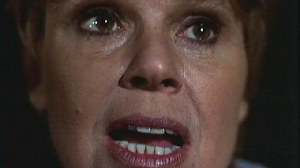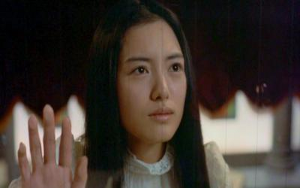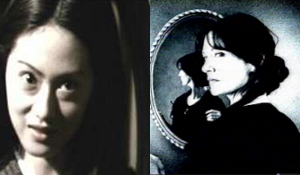Richard Eisenbeis put up a really interesting article at Kotaku today that I had to respond to. Essentially, he argues that horror films that turn their villains into empathetic figures take away from the fear they’re trying to create. If you feel bad or actively root for the bad guy, you’re embracing the horror rather than being repulsed by it. He argues his point well.
I do disagree with it. I believe that empathy, like any other narrative tool in horror, can be used to great effect.
Take, for example, the original Friday the 13th. For most of the film, the teens hanging out at Camp Crystal Lake are killed off one by one by an unknown figure. This figure is attacking them when they have sex, use drugs, or otherwise behave in a way that would put children in danger if the summer camp was in session.

Mrs. Vorhees is just a sweet grieving mother with a machete
In no way does feeling sorry for Mrs. Vorhees take away from the surprise reveal of the serial killer in Friday the 13th. If anything, knowing that the killer is a woman driven mad by immense grief makes the conclusion all the more terrifying. We never know what can push a person over the edge and here we can pinpoint the exact moment a horror icon is born.
This is not to say that every film uses the device as well as screenwriter Victor Miller and director Sean S. Cunningham did in Friday the 13th. Eisenbeis specifically cites the Japanese horror film Ring 0: Birthday as the inspiration for his article. There, the sad origins of Sadako (the villain of The Ring series) are explored in full detail before she becomes the horror icon we know her as today. Everyone she knows abuses her and behaves in terrible ways. We want Sadako to destroy the people who destroyed her so there is no traditional horror tension in the final act. Ring 0: Birthday is clearly a horror film, but it’s not a particularly strong one.

Sadako didn’t ask to be born like this. Who could hurt this sweet young woman?
There needs to be a distinction made between empathetic character development and storytelling devices. Empathy alone does not make a great or likable character. The Scream series has a lot of villains who clearly explain their motivations. This does not negate their crimes but make their mental and emotional states clear. Family, friends, and co-workers scorned by the legacy of the murders in Woodsboro and the Prescott family are usually shown as likable members of the community before the climactic reveal of their true identities. The failure or success of these films does not rely on relating to the villains. They succeed or fail based on whether or not the story has enough internal structure and logic to draw the viewer in.
The Ring and Ringu are actually perfect examples of this distinction. The opening scene is the shocking death of teenagers who watched a cursed video tape and were doomed to die seven days later. We’re meant to be terrified of the curse and whatever caused it from the start of the film.
From there, a parent (mother in the US version, father in the Japanese version) watches the tape in a remote cabin and begins to experience the curse first-hand. They set out to solve the mystery of the tape to free themselves, only to accidentally put their families in danger by leaving the tapes where they can be watched at home. Now they have less than a week to solve the mystery for themselves and their families.

Poor Shizuko and Anna are punished for being different.
Her daughter, Samara /Sadako inherited these abilities. She had a terrible childhood caused by her mother’s exile from the community. Samara/Sadako developed a lot of rage from the pain her mother experienced and began lashing out with their own powers.
In both versions of the film, the little psychic girl killing from beyond the grave is a deeply sympathetic figure. Everyone can relate to rejection, fear, and anger. The parent/heroes of the films feel so much empathy that they assume releasing these inner demons will solve the curse and free sweet, innocent children from the hell the world created. You begin to root for everyone getting out of this curse and living happily ever after.
But does it actually end that way? No. The sinister twist of the story is all the more effective for being misdirected with empathy for the character we know is the villain all along. The screenplays use an empathetic backstory as red herrings for the darker resolutions of the stories. Empathy allows the viewer to relate to the villains in a way that brings out more scares. This character development is just a well-executed storytelling device in both versions to wring out every drop of terror.
I don’t know if The Ring/Ringu could have had as much punch if Samara/Sadako weren’t tragic and oddly lovable characters in their own right. The parent figures could have circled down the drain even longer, never finding out anything substantial about the killer ghosts until they had no choice but to try final desperate maneuvers. Another character could have arrived to start the third act with insight into the only way to stop the curse. Would they have the punch of being tricked by emotional investment into believing in a happily ever after? Probably not.
Richard Eisenbeis’ article “How Empathy Takes the Fear out of Horror” is an excellent read. He raises a number of good points about when this device goes wrong. I just think his hypothesis is just a bit too broad to be as accurate as it could be. Feeling a strong emotional connection to a villain doesn’t necessarily make a horror film any less scary.
Thoughts on empathy and horror? Share them below.
